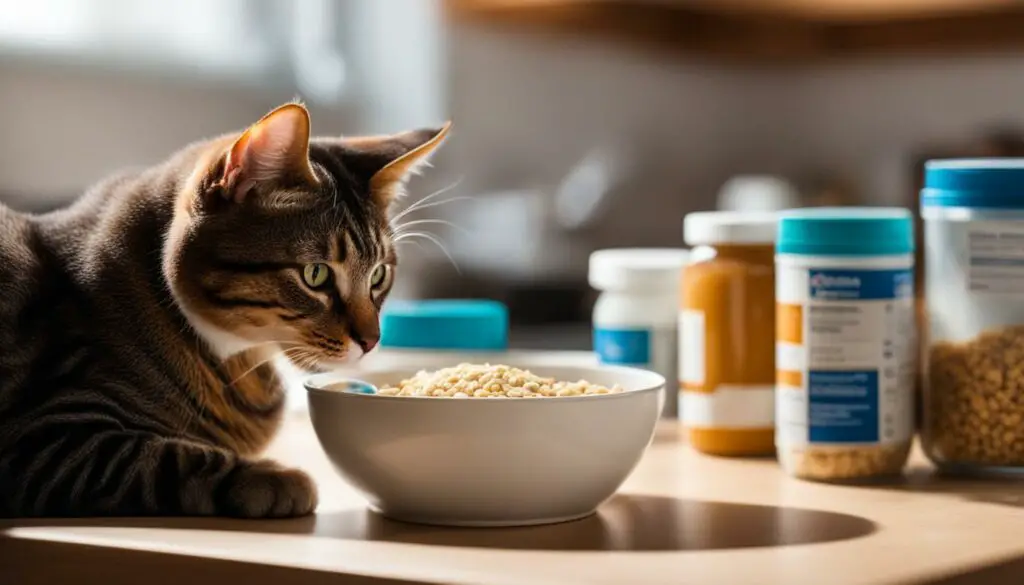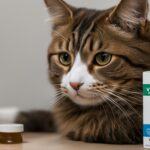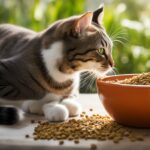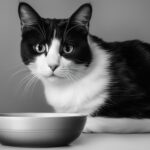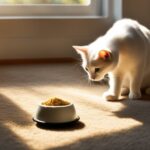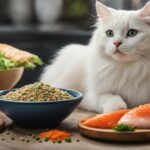If you’re struggling to get your cat to eat their prescribed therapeutic diet, you’re not alone. It can be frustrating and concerning when your furry friend refuses to eat the food that is meant to help manage their medical condition. But don’t worry, there are solutions and tips that can help entice your cat to eat their prescription food and ensure they get the necessary nutrition.
Understanding your cat’s food preferences and addressing any aversions they may have is essential. Some cats have specific tastes and textures they prefer, and it’s important to find alternative options that meet their needs. Additionally, adjusting the medication they receive can also play a role in improving their appetite.
In this article, I will provide you with practical advice on how to make your cat eat prescription food, alternative cat food options to consider, and cat food recommendations to ensure your cat gets the nutrition they need to manage their medical condition. Let’s dive in!
Key Takeaways:
- Understand your cat’s food preferences and aversions to find alternative options they will enjoy.
- Adjusting medication may improve your cat’s appetite and willingness to eat prescription food.
- Consider alternative cat food options, such as over-the-counter diets, with veterinary guidance.
- Experiment with flavor enhancers and temperature to entice your cat to eat their prescription food.
- Creating a calm and positive feeding environment can help reduce stress and increase appetite.
Understanding Therapeutic Diets for Cats
Therapeutic diets play a crucial role in managing medical conditions in cats. These specialized diets are designed to provide the necessary nutrition and support to help cats with specific diseases. Unlike over-the-counter diets, therapeutic diets have special properties tailored to address the unique needs of cats with underlying health conditions. These diets are formulated to provide the optimal balance of nutrients, vitamins, and minerals that can aid in disease management and promote overall health.
When it comes to selecting the right therapeutic diet for your cat, it is essential to consult with your veterinarian or a veterinary nutritionist. They have the expertise to assess your cat’s specific condition and recommend the most suitable options. Each therapeutic diet has its own set of ingredients and nutritional composition, and they are carefully developed to ensure they meet the unique dietary requirements of cats with specific medical conditions. Consulting with a professional will help you determine the most appropriate therapeutic diet for your cat’s needs.
In addition to managing underlying medical conditions, therapeutic diets may also have additional benefits. Some diets may help improve digestion, reduce inflammation, support joint health, or promote a healthy skin and coat. The specific properties of each therapeutic diet vary depending on the intended use and the condition it targets. Veterinary nutritionists stay up-to-date with the latest research and advancements in feline nutrition, ensuring they provide the most accurate and effective dietary recommendations for cats with medical conditions.
| Benefits of Therapeutic Diets for Cats |
|---|
| Provides the optimal balance of nutrients, vitamins, and minerals |
| Targets specific medical conditions and promotes overall health |
| May improve digestion, reduce inflammation, and support joint health |
| Developed by veterinary nutritionists with specialized expertise |
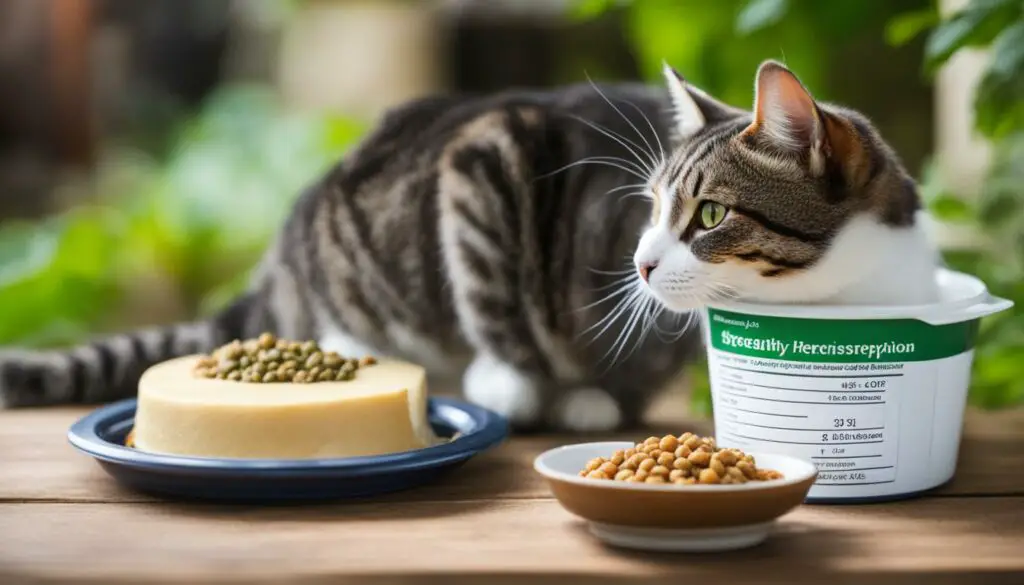
By understanding the importance of therapeutic diets for cats and consulting with professionals, you can ensure that your cat receives the optimal diet to manage their medical condition. These diets are specifically formulated to provide the necessary nutrients and support for cats with specific health concerns, and they can play a significant role in improving their overall well-being.
Common Reasons for Refusal to Eat Prescription Food
A cat refusing to eat their prescribed therapeutic diet can be a cause for concern. There are several common reasons why a cat may exhibit a reduced or altered appetite for their prescription food:
- Underlying Medical Conditions: Cats with underlying medical conditions may experience a decrease in appetite or a change in their taste preferences. It is important to consult with a veterinarian to determine if there are any underlying health issues that need to be addressed.
- Medication Side Effects: Some medications can affect a cat’s appetite, causing them to lose interest in their prescription food. If you suspect that medication may be the cause, consult with your veterinarian to discuss potential alternatives or adjustments.
- Stress: Cats are sensitive creatures and can be easily stressed by changes in their environment or routine. Stressors such as moving to a new home, the addition of another pet, or loud noises can impact a cat’s appetite. Creating a calm and peaceful feeding area can help alleviate stress and improve their appetite.
- Weakness: Cats that are weak due to illness or excessive physical activity may have a decreased appetite. It is important to provide them with proper rest and nutrition to regain their strength and appetite.
Identifying the underlying cause of a cat’s refusal to eat their prescription food is crucial in finding a solution. Consult with a veterinarian to determine the best course of action and address any medical or behavioral concerns.
“Understanding why a cat refuses to eat their prescription food is the key to finding a solution and ensuring they receive the necessary nutrition to manage their medical condition.
Table: Common Reasons for Refusing Prescription Food
| Reason | Description |
|---|---|
| Underlying Medical Conditions | Cats with medical conditions may exhibit a reduced or altered appetite for their prescription food. |
| Medication Side Effects | Some medications can cause a decrease in appetite, making a cat less interested in their prescribed diet. |
| Stress | Changes in the environment or routine can lead to stress, affecting a cat’s appetite. |
| Weakness | Cats that are weak due to illness or excessive physical activity may have a decreased appetite. |
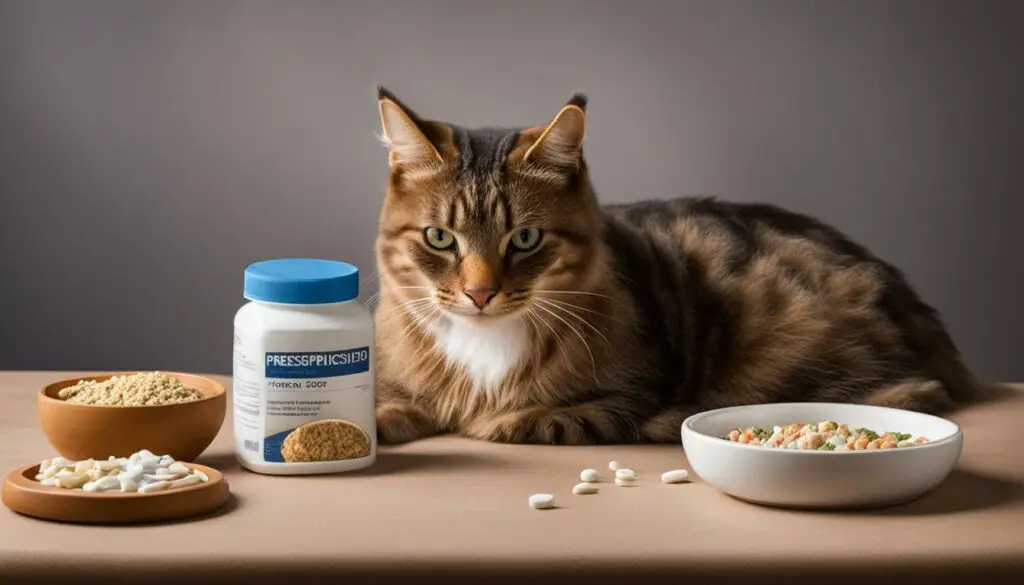
Understanding the common reasons for a cat’s refusal to eat their prescription food is the first step in finding a solution. By addressing any underlying medical conditions, adjusting medication if necessary, reducing stress, and providing the necessary support, you can help your cat regain their appetite and ensure they are receiving the nutrition they need to manage their medical condition.
Adjusting Medication for Improved Appetite
If your cat is not eating their prescribed food, it may be necessary to adjust their medication to better manage their underlying disease or reduce side effects. By optimizing the medical treatment, you can create an environment where your cat will be more inclined to eat their prescribed food. This adjustment of medication can help manage the disease more effectively and improve your cat’s overall appetite.
When adjusting medication, it is important to work closely with your veterinarian to ensure the right balance is achieved. They will evaluate your cat’s medical condition and recommend any necessary changes. By finding the optimal medication regimen, you can minimize any potential side effects that may be impacting your cat’s appetite.
Once the medication is optimized, you can explore different options for therapeutic diets. There are multiple commercial therapeutic diets available for different conditions, and it may be helpful to try different products to find the one that your cat prefers. It is important to provide variety and options to entice your cat to eat their prescribed food.
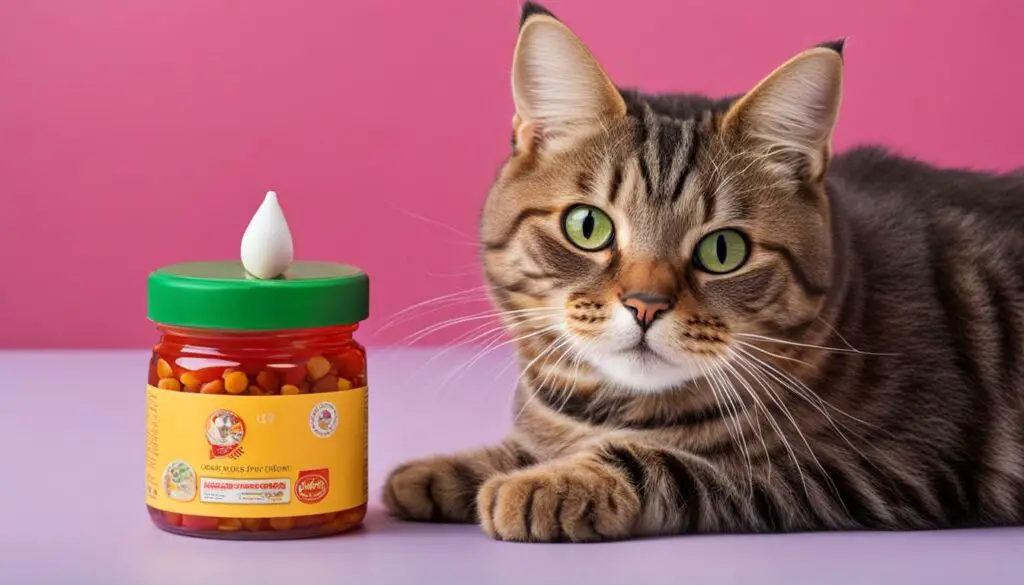
Table: Comparison of Multiple Therapeutic Diets
| Diet Name | Key Benefits |
|---|---|
| Therapeutic Diet A | – High palatability – Tailored for specific condition – Nutrient-rich ingredients |
| Therapeutic Diet B | – Balanced nutrition – Supports healthy digestion – Promotes weight management |
| Therapeutic Diet C | – Limited ingredient formula – Hypoallergenic – Supports skin and coat health |
| Therapeutic Diet D | – Low carbohydrate content – Supports urinary tract health – Controls blood glucose levels |
As shown in the table above, each therapeutic diet offers unique benefits tailored to specific conditions. It is essential to consult with your veterinarian to determine which diet is most suitable for your cat’s needs. Additionally, your veterinarian may recommend a gradual transition to the new diet to ensure your cat adapts well and continues to eat.
Using Flavor Enhancers and Temperature
To entice your cat to eat their prescription food, you can try using flavor enhancers and experimenting with different temperatures. Some cats may be more interested in their food if you add specific foods to enhance the flavor. Additionally, adjusting the temperature of canned food can make it more appealing to cats. There are also appetite stimulants available, such as Mirataz for cats and Entyce for dogs, which can help stimulate their appetite.
Flavor Enhancers
Adding flavor enhancers to your cat’s prescription food can make it more enticing for them to eat. You can try sprinkling a small amount of low-sodium chicken broth, tuna water, or Parmesan cheese on top of their food. These additives can help enhance the aroma and taste, making the food more appealing to your cat.
Temperature
Some cats prefer their food at room temperature, while others may enjoy it slightly warmed. You can experiment with heating up the canned food for a few seconds in the microwave or placing the food in a warm water bath. Be sure to test the temperature before offering it to your cat to ensure it is not too hot. Remember, cats have a more sensitive sense of smell, and warming their food can help release more enticing aromas.
Appetite Stimulants
If your cat’s lack of appetite persists, speak to your veterinarian about appetite stimulants such as Mirataz for cats or Entyce for dogs. These medications can help boost your cat’s interest in food and increase their appetite. It is important to follow your veterinarian’s instructions and dosage guidelines when using these medications for your cat.
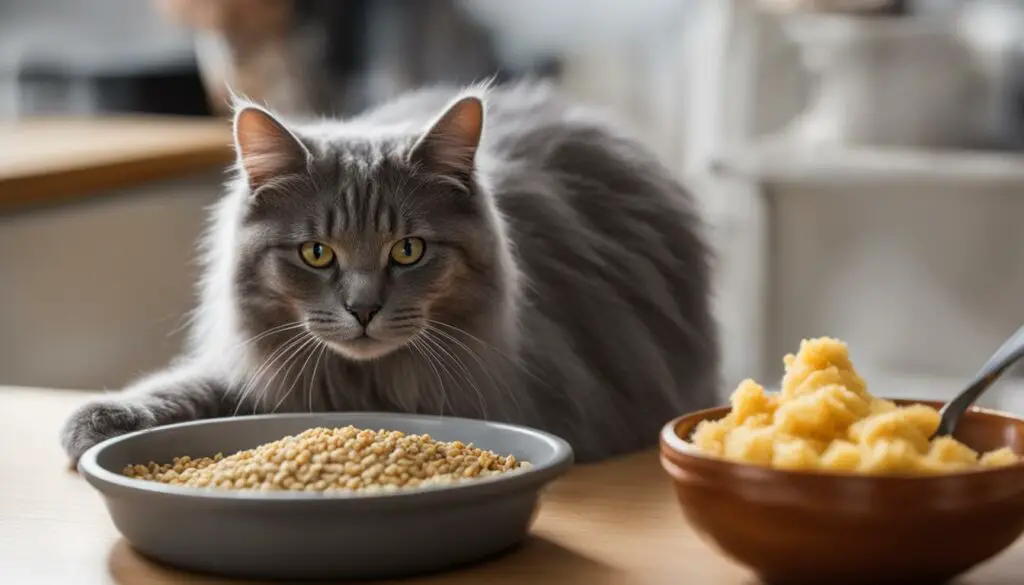
| Flavor Enhancers | Temperature | Appetite Stimulants |
|---|---|---|
| Low-sodium chicken broth | Room temperature | Mirataz for cats |
| Tuna water | Slightly warmed | Entyce for dogs |
| Parmesan cheese |
Considering Alternative Therapeutic Diets
If the cost of therapeutic diets is a concern or you need more options to improve your cat’s appetite, you can consider over-the-counter options. While these diets may not have the specific therapeutic properties of prescription food, they can still provide adequate nutrition for your cat. However, it is crucial to consult with your veterinarian before trying any diet not specifically recommended for your cat’s medical condition.
When exploring over-the-counter options, look for reputable brands that prioritize quality ingredients and have a solid reputation in the pet food industry. This ensures that the food meets certain standards and is more likely to provide the necessary nutrients for your cat’s well-being. Additionally, consider grain-free options if your cat has specific dietary restrictions. However, be aware that recent studies have linked grain-free diets to a higher risk of heart disease in some cats. It’s important to weigh the pros and cons and consult with your veterinarian before making any dietary changes.
In some cases, a high carb, low protein diet may be necessary to support your cat’s kidney function. This is typically recommended for cats with kidney disease. If this is the case for your cat, consult with your veterinarian to find the most appropriate diet and ensure that it meets your cat’s nutritional needs. Remember, every cat is unique, and what works for one cat may not work for another. It’s essential to consider your cat’s specific medical condition, preferences, and nutritional requirements when choosing an alternative therapeutic diet.
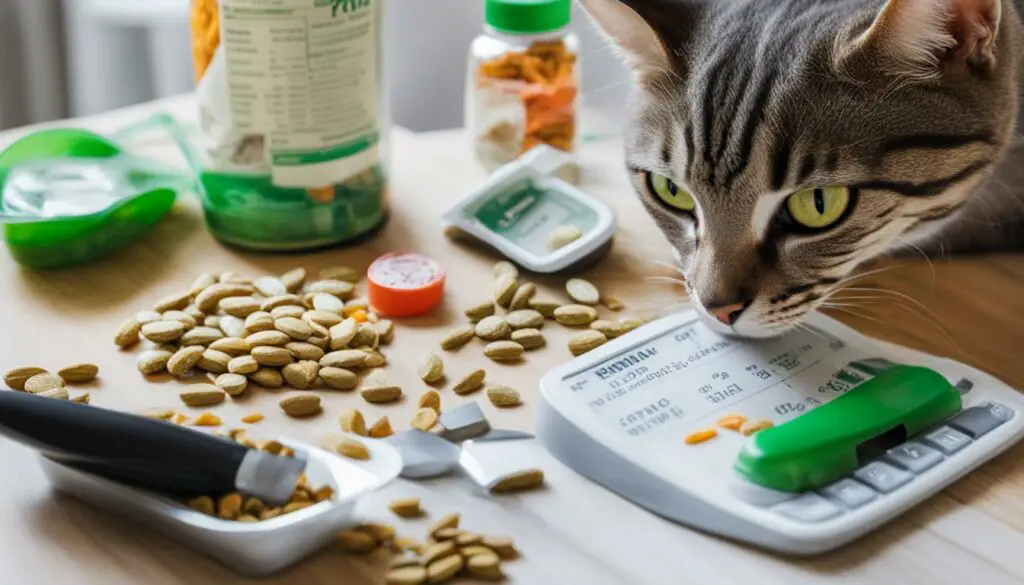
| Pros of Over-the-Counter Options | Cons of Over-the-Counter Options |
|---|---|
| 1. Cost-effective compared to prescription diets. | 1. May not have specific therapeutic properties for managing certain medical conditions. |
| 2. Provides additional options to entice your cat to eat. | 2. Quality and ingredients may vary among brands. |
| 3. May be more readily available than prescription diets. | 3. Grain-free options may carry a higher risk of heart disease in some cats. |
Understanding Your Cat’s Food Preferences
When it comes to feeding our feline friends, it’s crucial to understand their unique food preferences. Just like humans, cats have individual tastes and aversions when it comes to their meals. By catering to their preferences, we can help ensure they have a positive experience at mealtimes and maintain a healthy appetite.
One important factor to consider is the feeding location. While some cats are social eaters and prefer to have company while eating, others may prefer a quiet and secluded spot where they can dine in peace. By observing your cat’s behavior, you can determine whether they prefer to eat in a communal area with the family or in a more private space.
Another consideration is the feeding schedule. Establishing a regular mealtime routine can help regulate your cat’s hunger and prevent overeating or food aversions. Instead of leaving food out all day, feeding your cat 2-3 meals at specific times can create a sense of anticipation and ensure they are hungry when it’s time to eat.
To further entice your cat to eat, you can experiment with different flavors and textures. Some cats prefer wet food over dry kibble, while others may have specific preferences for fish or poultry. Gradually introducing new foods and observing your cat’s response can help you determine their likes and dislikes. However, it’s important to ensure any additions are safe for cats and do not contain ingredients that can be harmful.
Feeding Location
| Preference | Description |
|---|---|
| Social Eaters | Prefer to eat in communal areas with the family |
| Private Eaters | Prefer a quiet and secluded spot for dining |
Feeding Schedule
Establishing a regular mealtime routine can help regulate your cat’s hunger and prevent overeating or food aversions. Feeding your cat 2-3 meals at specific times can create a sense of anticipation and ensure they are hungry when it’s time to eat.
Cat Food Preferences
- Experiment with different flavors and textures to determine your cat’s preferences
- Gradually introduce new foods and observe their response
- Ensure any additions are safe for cats and do not contain harmful ingredients
Optimal Bowl Type for Feeding
When it comes to feeding your cat, the type of bowl you use can make a difference in their eating experience. Certain bowls can help alleviate whisker fatigue, a condition where a cat’s sensitive whiskers get stressed from touching the sides of a deep bowl. To ensure your cat has a comfortable mealtime, consider the following bowl options:
| Bowl Type | Description |
|---|---|
| Stainless Steel Bowls | These bowls are durable, easy to clean, and resistant to bacteria growth. They are also safe for cats and can help prevent allergic reactions. |
| Ceramic Bowls | Ceramic bowls are another excellent choice. They are heavy and stable, so they won’t tip over easily. Additionally, they come in various sizes, colors, and designs, allowing you to find one that suits your cat’s style. |
| Glass Bowls | Glass bowls are hygienic and easy to clean, ensuring your cat’s food stays fresh. They are also free from harmful chemicals that may leach into the food. |
| Plastic Bowls | While plastic bowls are lightweight and inexpensive, they can harbor bacteria, scratch easily, and emit odors that may deter cats from eating. |
Remember, the goal is to provide your cat with a comfortable and stress-free eating experience. If your cat is experiencing whisker fatigue or showing aversion to their current bowl, it may be worth trying an alternative option. By choosing the right bowl, you can help your cat enjoy their meals and ensure they get the nutrition they need.
Alternative Feeding Methods
When it comes to feeding our cats, the traditional bowl is not the only option. Some cats may find mealtime more engaging and satisfying with alternative feeding methods. These methods tap into their natural instincts and provide mental stimulation and exercise. Let’s explore some options:
No Bowl Feeding System
The no bowl feeding system is designed to mimic hunting behavior and make mealtime more interactive for your cat. These feeding systems often come in the form of puzzle toys or mouse-shaped devices that dispense food when your cat interacts with them. This engages their natural hunting instincts, making mealtime more exciting and rewarding.
Food Puzzles
Food puzzles are another great way to engage your cat’s hunting behavior. These puzzles require your cat to work for their food by manipulating the puzzle to release the treats or kibble. Food puzzles come in various designs and difficulty levels, allowing you to choose the one that best suits your cat’s abilities. Not only do food puzzles provide mental stimulation, but they also slow down your cat’s eating pace, preventing them from scarfing down their food and potentially vomiting it back up.
Periodic Small Feedings
Instead of feeding your cat one or two large meals a day, you can try offering them multiple small meals throughout the day. This approach mimics how cats would naturally eat in the wild, where they would hunt and eat small prey multiple times a day. This feeding method can help satisfy your cat’s hunting instincts and prevent them from becoming too full or hungry between meals.
Engaging Hunting Behavior
Engaging your cat’s hunting behavior during mealtime can also entice them to eat. You can try hiding small portions of their food around the house, encouraging them to use their sense of smell and hunt for their meal. This can be particularly stimulating for indoor cats who may lack opportunities to exhibit their natural hunting instincts. Just be sure to use dry food or treats for this method to prevent any spoilage.
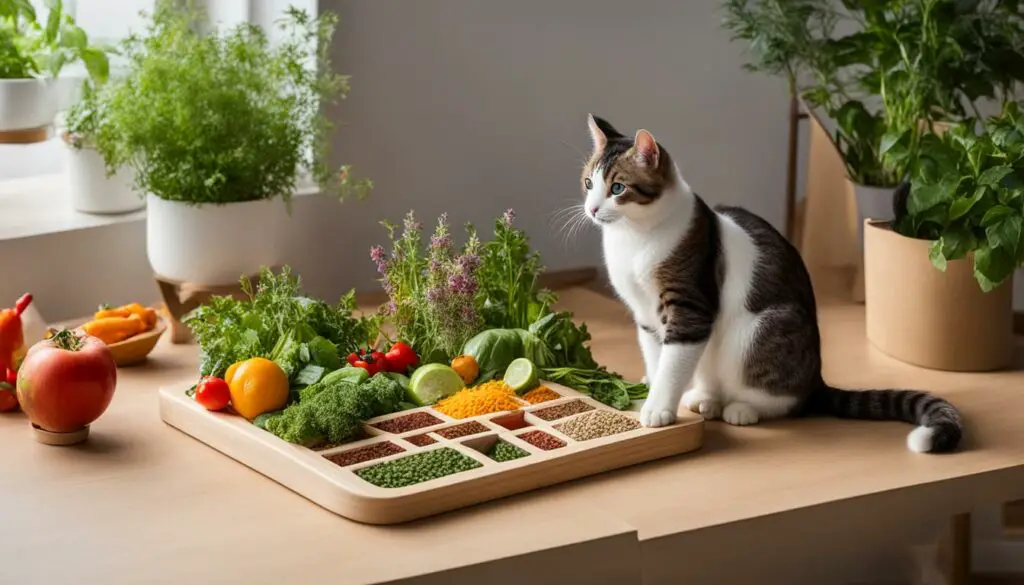
By incorporating alternative feeding methods into your cat’s mealtime routine, you can provide them with a more enriching and satisfying experience. These methods stimulate their natural instincts, provide mental stimulation, and make mealtime a fun and engaging activity. Remember to introduce these methods gradually and consult with your veterinarian if you have any concerns about your cat’s specific dietary needs.
Hand Feeding as a Last Resort
If all other options fail and your cat still refuses to eat their prescription food, hand feeding can be a last resort to ensure they are getting the necessary nutrition. This method is particularly effective for social eaters who respond well to close interaction with their owner. Hand feeding involves using canned food on your finger or in your hands as a bowl to offer small amounts of food to your cat.
When hand feeding, it is crucial to avoid force-feeding, as it can create further food aversions and stress for your cat. Instead, gently offer the food to your cat and allow them to lick it off your finger or from your hand. This method can help establish a positive association with the food and encourage them to start eating on their own.
It is important to note that hand feeding should only be used as a long-term solution under the guidance of your veterinarian. There may be underlying medical or behavioral issues that need to be addressed, and your veterinarian can provide further guidance and support to ensure your cat’s overall health and well-being.
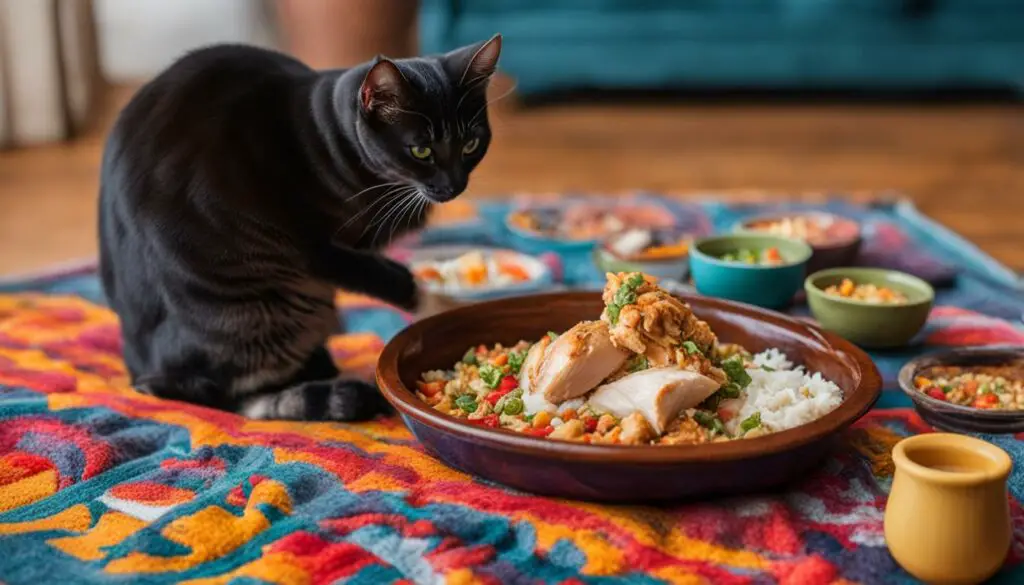
Table: Comparison of Canned Food vs. Dry Food for Hand Feeding
| Canned Food | Dry Food | |
|---|---|---|
| Texture | Moist and soft, easier to consume | Hard and crunchy, requires more effort to eat |
| Palatability | Intense flavors and aromas, more appealing to cats | Less flavorful, may be less enticing for picky eaters |
| Nutritional Content | Contains higher moisture content, helps promote hydration | Lower moisture content, may not provide adequate hydration |
| Storage | Requires refrigeration after opening, shorter shelf life | Can be left out at room temperature, longer shelf life |
“Hand feeding should only be a long-term solution with veterinary guidance, as there may be underlying medical or behavioral issues at play.”
Social Eaters and Hand Feeding
Social eaters, or cats that prefer to eat in the presence of their owners, may respond well to hand feeding. The close interaction and bonding that occurs during hand feeding can create a positive feeding experience for these cats. It is important to be patient and allow your cat to eat at their own pace, offering small amounts of food throughout the day. This method can also help monitor your cat’s appetite and ensure they are eating enough to meet their nutritional needs.
Establishing a Feeding Schedule
When it comes to feeding your cat, establishing a consistent schedule can have numerous benefits. Not only does it help regulate your cat’s hunger, but it also prevents issues such as scarfing and regurgitation. Feeding your cat multiple meals per day, instead of leaving food out all the time, can help ensure that they are hungry and eager to eat when it’s mealtime.
A feeding schedule can be particularly beneficial for cats that have specific dietary needs, such as those on prescription food. By providing structured mealtimes, you can monitor your cat’s appetite and ensure that they are consuming the necessary nutrition to support their health and well-being.
Additionally, maintaining a feeding schedule can also help keep your cat’s food fresh. Cats rely heavily on their sense of smell and taste when it comes to determining if food is appetizing. By serving meals at specific times, you can ensure that the food is at its freshest, enhancing the overall appeal for your cat.
Preventing Scarf and Barf
One common issue that can arise when cats are fed free-choice or given large quantities of food at once is scarf and barf. This phenomenon occurs when cats eat too quickly and then vomit shortly after. By implementing a feeding schedule, you can encourage your cat to eat at a slower pace, reducing the likelihood of scarf and barf episodes.
When establishing a feeding schedule for your cat, it’s important to consider their individual needs and preferences. Some cats may prefer smaller, more frequent meals, while others may do well with larger meals spaced throughout the day. Consulting with your veterinarian can help determine the optimal feeding schedule for your cat based on their specific requirements.
Table 11: Sample Feeding Schedule for Cats
| Time | Meal |
|---|---|
| 8:00 AM | Breakfast |
| 12:00 PM | Mid-Morning Snack |
| 4:00 PM | Afternoon Meal |
| 8:00 PM | Dinner |
Remember, every cat is unique, and it may take some time to find the feeding schedule that works best for them. Be patient and observe your cat’s behavior and appetite to make any necessary adjustments. By establishing a feeding schedule, you can ensure that your cat is well-nourished, minimize food-related issues, and create a positive feeding environment for them.
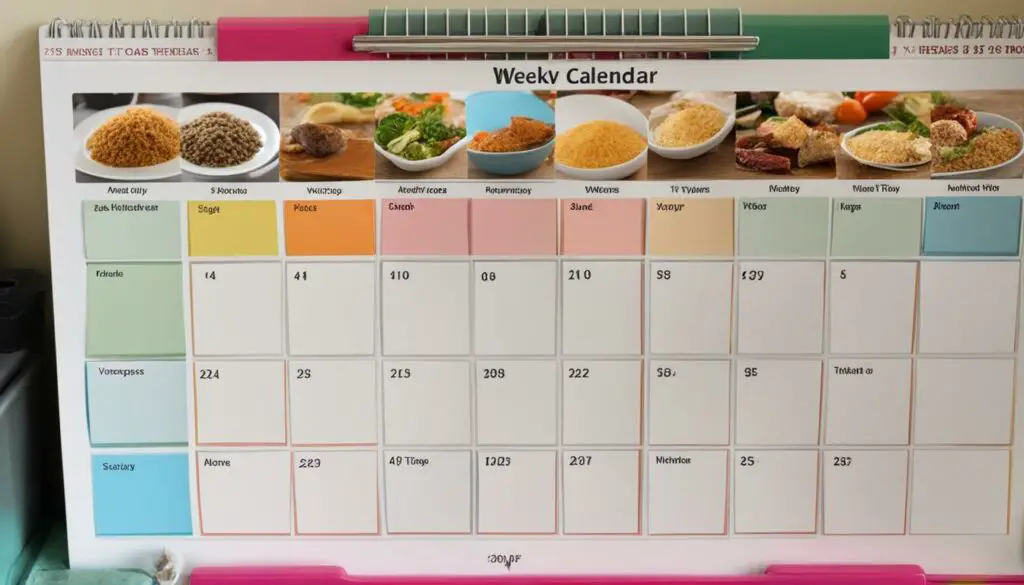
Cat-Safe Enticements and Flavors
When your cat is refusing to eat their prescription food, you can try incorporating natural enticements and flavors to make the food more appealing. Gradual introduction of new foods can help your cat adjust and develop a taste for their prescription diet. Here are some options that can entice your cat to eat:
- Adding canned food: Mixing a small amount of canned food with their prescription food can enhance the flavor and texture, making it more enticing for your cat.
- Warm chicken broth: Adding warmed, low-sodium chicken broth to their food can add moisture and flavor, making it more appetizing for your cat.
- Meat baby food: Mixing a small amount of meat baby food (without any added seasonings or onions) with their prescription food can provide a flavorful boost.
- Fish oil: Adding a small amount of fish oil to their food can provide a tempting aroma and taste that may entice your cat to eat.
Remember to consult with your veterinarian before introducing any new foods or flavors to ensure they are safe for your cat’s specific condition.
“Gradual introduction of new foods can help your cat adjust and develop a taste for their prescription diet.”
By incorporating these cat-safe enticements and flavors, you can increase the chances of your cat eating their prescribed therapeutic diet. However, it is important to note that while these additions can help entice your cat, they should not replace the prescription food entirely. The prescription diet is formulated specifically to meet your cat’s nutritional needs based on their medical condition, so it is essential to prioritize their health.
| Flavor Additions | Benefits |
|---|---|
| Canned food | Enhances flavor and texture |
| Warm chicken broth | Adds moisture and flavor |
| Meat baby food | Provides a flavorful boost |
| Fish oil | Offers a tempting aroma and taste |
With these options in mind, you can experiment and find the combinations that work best for your cat. Remember to introduce new foods gradually and monitor their response. If your cat continues to refuse their prescription food, consult with your veterinarian for further guidance and recommendations.
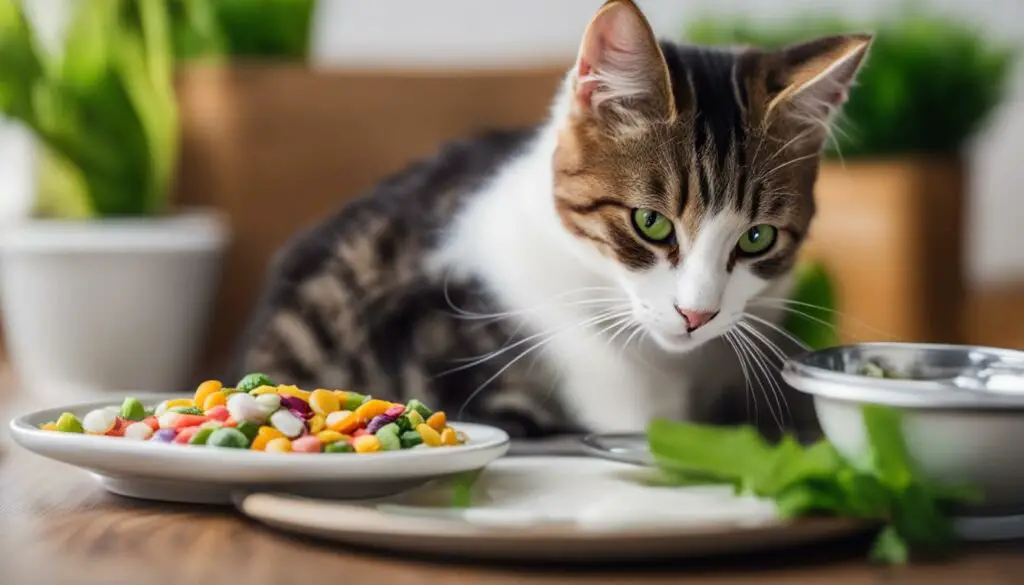
Ensuring a Positive Feeding Environment
Creating a calm and comfortable feeding environment is crucial for your cat to eat without stress and anxiety. A relaxed and stress-free cat is more likely to have a healthy appetite and enjoy their meals. To achieve this, consider using a Feliway Diffuser, which emits pheromones that mimic the scent of a mother cat, creating a calming effect. The Feliway Diffuser can help reduce stress and create a relaxed atmosphere during mealtimes. Simply plug it into an electrical outlet in the room where your cat eats, and allow the pheromones to create a soothing environment.
Additionally, it is important to choose a feeding location that your cat feels safe and undisturbed in. Cats are sensitive to their surroundings, so placing their food bowls in a quiet area where they can eat without feeling threatened or interrupted can contribute to a positive feeding experience. Avoid placing the food bowls near loud appliances or in high-traffic areas. Providing a peaceful and calm feeding environment will help your cat feel at ease and more receptive to eating their prescribed food.
In summary, a calm feeding environment is essential for ensuring that your cat eats their prescription food without stress and anxiety. By using a Feliway Diffuser and selecting a quiet and safe feeding location, you can help create a positive environment that promotes relaxation and encourages your cat to enjoy their meals. Remember, a relaxed cat is more likely to have a healthy appetite and receive the necessary nutrition to manage their medical condition.
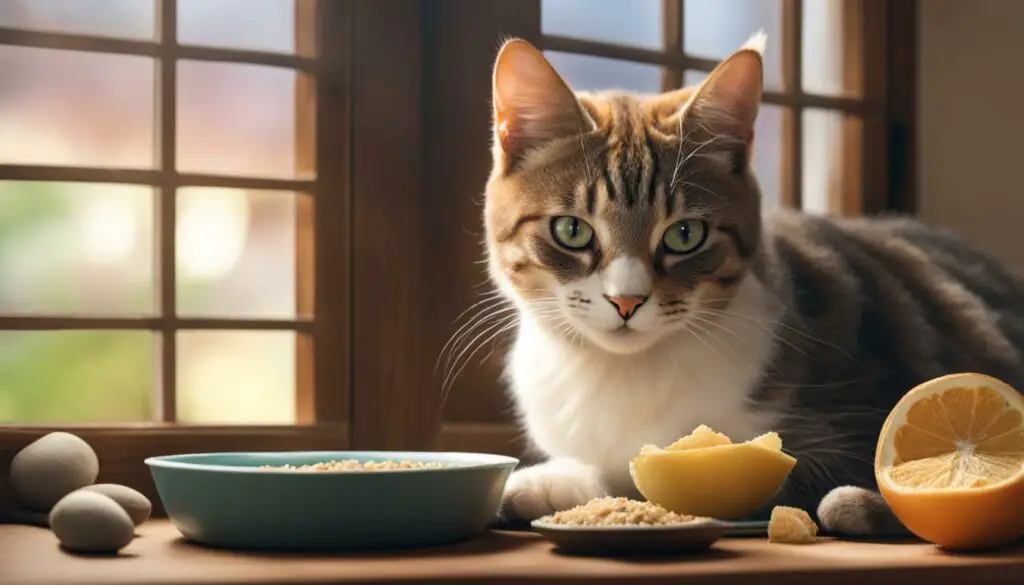
Table: Tips for Creating a Calm Feeding Environment
| Tip | Description |
|---|---|
| Use a Feliway Diffuser | Plug in a Feliway Diffuser in the feeding area to emit calming pheromones and reduce stress. |
| Select a quiet location | Choose a peaceful area away from noise and distractions to provide a safe and undisturbed environment for your cat to eat. |
| Avoid high-traffic areas | Place the food bowls away from areas with frequent foot traffic to minimize disruptions and create a calm atmosphere. |
| Keep feeding area clean | Maintain a clean and odor-free feeding area to ensure your cat feels comfortable and motivated to eat. |
Seeking Veterinary Advice
If you are facing difficulties in getting your cat to eat their prescribed food, it is crucial to seek the guidance of a veterinarian. They have the expertise to assess your cat’s underlying health issues and address any behavioral concerns that may be contributing to their refusal to eat. A veterinary consultation is essential to determine the most appropriate diet for your cat’s specific condition and ensure they receive the necessary nutrition.
Veterinarians can conduct a thorough medical assessment to identify any underlying health problems that may be affecting your cat’s appetite. They can also recommend appropriate adjustments to their medication, if necessary, to manage their disease more effectively. With their professional advice, you can explore different commercial therapeutic diets that are specifically formulated for your cat’s condition and preferences.
Remember, each cat is unique, and what works for one may not work for another. Seeking veterinary advice ensures that you receive personalized recommendations tailored to your cat’s specific needs. Whether it’s identifying the right diet, addressing behavioral concerns, or managing underlying health issues, a veterinarian can provide the necessary support and guidance to help your cat regain their appetite and maintain their overall well-being.
| Veterinarian Consultation Benefits | Underlying Health Issues | Behavioral Concerns | Appropriate Diet | Medical Assessment |
|---|---|---|---|---|
| Expert guidance from professionals | Identification and management | Addressing behavioral factors | Specific to your cat’s condition | Thorough evaluation of health |
| Personalized recommendations | Optimizing medication | Promoting a positive feeding experience | Tailored to their preferences | Identifying any underlying issues |
| Targeted solutions for your cat | Ensuring optimal disease management | Supporting overall well-being | Nutritionally balanced | Monitoring progress and adjusting as needed |
Consultation with a Veterinary Nutritionist
When it comes to your cat’s health and nutrition, seeking the expertise of a veterinary nutritionist can make a significant difference. A veterinary nutritionist is a specialist who can develop an individualized dietary plan tailored to your cat’s specific needs. With their specialized knowledge and experience, they can ensure that your cat receives optimal nutrition to support their overall well-being and manage any medical conditions they may have.
A consultation with a veterinary nutritionist involves a comprehensive assessment of your cat’s health history, current medical condition, and specific dietary requirements. They will take into consideration factors such as age, weight, activity level, and any dietary restrictions or preferences. Based on this evaluation, the nutritionist will create a customized diet plan that meets your cat’s nutritional needs while addressing their specific health concerns.
Working closely with your veterinarian, the veterinary nutritionist can provide valuable insights and recommendations to help improve your cat’s appetite and ensure they are receiving the necessary nutrients. They may suggest appropriate commercial therapeutic diets or even formulate a prescription diet specifically tailored to your cat’s needs. Additionally, they can guide you on portion sizes, feeding schedules, and any necessary supplements to complement your cat’s diet.
Benefits of Consulting with a Veterinary Nutritionist
There are several key benefits to consulting with a veterinary nutritionist:
- Specialized Expertise: Veterinary nutritionists have extensive knowledge and training in animal nutrition, allowing them to develop customized dietary plans that address specific medical conditions.
- Individualized Dietary Plan: A veterinary nutritionist will create a diet plan tailored to your cat’s unique needs, ensuring they receive the optimal balance of nutrients for their overall health and specific condition.
- Optimal Nutrition: By working with a veterinary nutritionist, you can be confident that your cat is receiving the best possible nutrition to support their well-being and manage their medical condition.
| Requirement | Benefit |
|---|---|
| Specialized Expertise | Veterinary nutritionists have extensive knowledge and training in animal nutrition, allowing them to develop customized dietary plans that address specific medical conditions. |
| Individualized Dietary Plan | A veterinary nutritionist will create a diet plan tailored to your cat’s unique needs, ensuring they receive the optimal balance of nutrients for their overall health and specific condition. |
| Optimal Nutrition | By working with a veterinary nutritionist, you can be confident that your cat is receiving the best possible nutrition to support their well-being and manage their medical condition. |
Overall, consulting with a veterinary nutritionist can provide valuable guidance and expertise to help you navigate your cat’s dietary needs. With their specialized knowledge, they can help optimize your cat’s nutrition while ensuring they enjoy their meals and stay healthy.
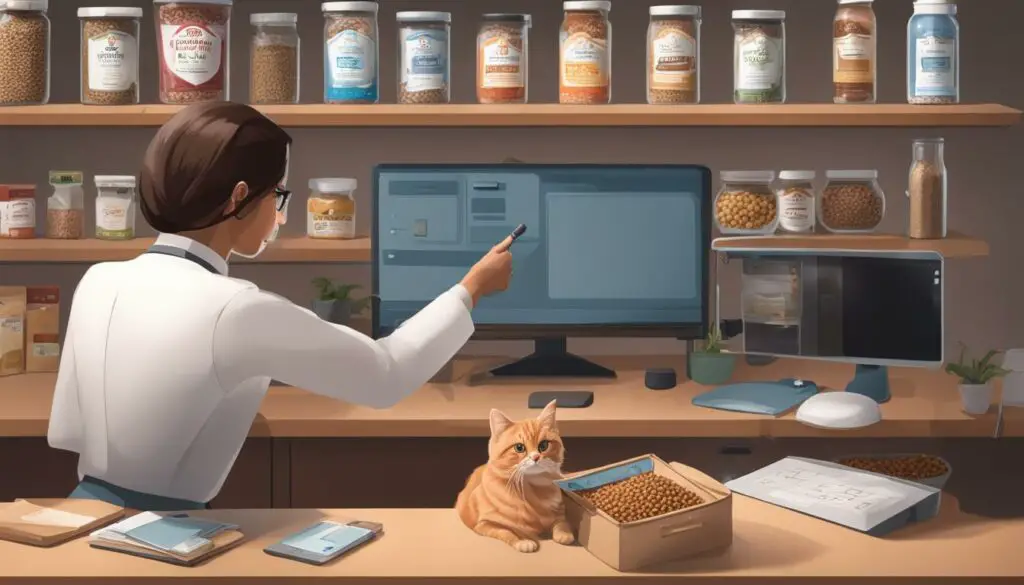
Conclusion
In conclusion, dealing with a cat that refuses to eat prescription food can be quite a challenge. However, there are several solutions and tips that can help you entice your cat to eat and ensure they receive the necessary nutrition to manage their medical condition.
Firstly, it’s important to consult with your veterinarian to address any underlying health issues or behavioral concerns that might be contributing to your cat’s refusal to eat. They can recommend the most appropriate diet for your cat’s specific condition and provide guidance on medication adjustments if needed.
Additionally, there are various strategies you can try to entice your cat to eat their prescription food. Experimenting with different flavors, temperatures, and feeding methods can make the food more appealing to your cat. You can also consider using natural enticements, such as chicken broth or meat baby food, to enhance the flavor.
Lastly, creating a positive feeding environment is crucial. Keep the feeding area calm and consider using pheromone diffusers, like Feliway, to reduce stress. Establishing a feeding schedule and using appropriate bowl types can also contribute to a more enjoyable mealtime experience for your cat.
Remember, each cat is unique, so it may take some trial and error to find the right approach for your feline friend. Be patient, persistent, and don’t hesitate to seek the advice of a veterinary nutritionist for personalized dietary plans. With time and effort, you can help your cat overcome their aversion and ensure they receive the nourishment they need to thrive.
FAQ
Why is my cat refusing to eat their prescribed therapeutic diet?
There can be several reasons for this, including underlying medical conditions, medication side effects, stress, and weakness. It’s important to address the underlying cause to help your cat regain their appetite.
Should I adjust my cat’s medication if they are not eating their prescribed food?
Yes, it may be necessary to optimize their medical treatment to better manage their underlying disease or reduce side effects. Consult with your veterinarian for guidance.
Are there different options for therapeutic diets?
Yes, there are multiple commercial therapeutic diets available for different conditions. It may be helpful to try different products to find the one that your cat prefers. Consult with your veterinarian or a veterinary nutritionist for recommendations.
How can I entice my cat to eat their prescription food?
You can try using flavor enhancers, experimenting with different temperatures, and offering different food textures. Adding natural enticements like warmed, low-sodium chicken broth or mixing in meat baby food can also help.
Can I try over-the-counter options if my cat refuses to eat their prescription food?
It’s best to consult with your veterinarian before trying any diet not specifically recommended for your cat. They can provide guidance and ensure the diet is appropriate for your cat’s condition.
How can I determine my cat’s food preferences?
Cats have individual preferences, so it’s important to understand what your cat likes. You can experiment with different flavors, feeding locations, and feeding schedules to see what works best for your cat.
What type of bowl should I use for feeding my cat?
It’s best to use shallow-sided bowls or plates to prevent whisker fatigue. Stainless steel, ceramic, and glass bowls are good options, while plastic bowls should be avoided.
What are alternative feeding methods I can try?
You can try a “no bowl” feeding system, food puzzles, or periodic small feedings to engage your cat’s natural hunting behavior. These methods can provide mental stimulation and prevent overeating.
Should I hand feed my cat if they refuse to eat?
Hand feeding can be a last resort to ensure your cat is getting the necessary nutrition. However, it should only be done with veterinary guidance, as there may be underlying medical or behavioral issues at play.
How can I establish a feeding schedule for my cat?
It’s best to feed your cat 2-3 meals per day at specific times to regulate their hunger and prevent overeating. This can also help prevent scarfing and regurgitation.
How can I make my cat’s food more enticing?
You can try adding natural enticements like warmed, low-sodium chicken broth or mixing in meat baby food. Gradually introducing new foods and flavors can help your cat adjust.
How can I create a positive feeding environment for my cat?
You can use a Feliway Diffuser to reduce stress and create a relaxed atmosphere. Placing the food bowls in areas where your cat feels safe and undisturbed can also contribute to a positive feeding experience.
When should I seek veterinary advice?
If you are struggling to get your cat to eat their prescription food, it’s important to consult with a veterinarian. They can assess your cat’s underlying health issues and recommend the most appropriate diet for their specific condition.
Is consultation with a veterinary nutritionist necessary?
In some cases, consulting with a veterinary nutritionist may be beneficial to develop an individualized dietary plan for your cat. They have specialized expertise in formulating diets for cats with specific medical conditions.
Are there any other solutions or tips for getting my cat to eat prescription food?
Each cat is unique, so it may require some trial and error to find the best approach for your cat. Be patient and persistent, and consult with your veterinarian for personalized advice.

